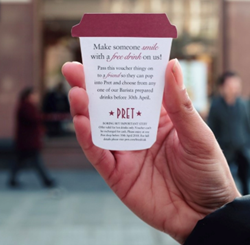Let’s build a sense of hope through the power of generosity. You might think that giving — versus selling — isn’t compatible with turning a profit. But psychologists would argue otherwise. Here are two ways to harness the positive effects of giving.
Giving brings joy
There’s a ton of research into the benefits of kindness for boosting mood. Most recently, we heard that daily acts of kindness can work just as well as antidepressants. Gift giving is of course an example of kindness. And there’s psychological evidence to show the buzz we get by being generous.
A 2008 study by Elizabeth Dunn, Lara Aknin (both from the University of British Columbia) and Michael Norton (from Harvard) set out to explore the link between spending on others and happiness.
They gave participants a sum of money ($5 or $20) and asked them to spend it by the end of the day. Half were told to spend it on themselves, half on someone else.
At the end of the study, the results were clear. Those who had spent their money on others were measurably happier than those who’d spent it on themselves. And, perhaps surprisingly, the amount they’d been given didn’t seem to impact their happiness level.
Giving, even just a little, cheers us up much more than ‘treating’ ourselves.
So what does this mean for marketers? Well, this study suggests that to make your customers happy, rather than offering freebies, you might be able to have more of an impact if you help them to give.

This could mean, for example, rather than giving customers money off discounts, give them vouchers designed to be passed on. This was the approach adopted by Pret, when they handed out the vouchers below:
This really does spread happiness: not only is the end recipient delighted, but the giver is too. And Pret gets a new customer, so it’s a clever way of doubling the impact of a voucher. Smiles for everyone.
A favour for a favour
Another key reason to focus on giving is the response it garners in the recipient. When someone does us a favour, or gives us a gift, we feel a social pressure to reciprocate.
Psychologists have built a solid bank of evidence that demonstrates the strength of our bias towards reciprocity. One example is a 2004 study by Armin Falk at the University of Bonn. He sent out 9,846 genuine letters asking for donations to a charity.
The recipients were split into two groups. Some received a standard letter with information about the charity and a request to donate. Others had the same message, in addition to a gift: either a single postcard or a pack of four. These were described as a “gift from the children of Dhaka”.
These different approaches produced markedly different donation rates. Those who had been sent gifts were significantly more likely to donate. In the group who’d received a single postcard, 17% more people donated to the charity compared to those who had the letter alone; among those who’d received the larger gift, a massive 75% more donated.
In another real-world example from 2013, the Behavioural Insights Team tested eight different messages based on behavioural science principles with the aim of boosting sign-ups for organ donation. The winner was one that employed reciprocity: “If you needed an organ transplant, would you have one? If so, please help others”.
Encouraging people to consider the notion of reciprocity was a significant motivation to act. In fact, so ingrained is our drive to return a favour, that we have even worked it into our language. A formal, and rather quaint, way to thank someone — “much obliged” — literally means you are now obligated to the person you’re thanking.
The bottom line for marketers: be generous. The more you give, the more you’ll get. And remind your customers what you have done for them to engender the natural desire to repay you in kind.
By showing generosity, and encouraging your customers to do the same, you’re spreading happiness – whilst growing your brand. So there’s hope all round.
Richard’s new book on applying behavioural science to marketing, The Illusion of Choice, is now available to buy.
Featured image: Andrea Piacquadio / Pexels



































